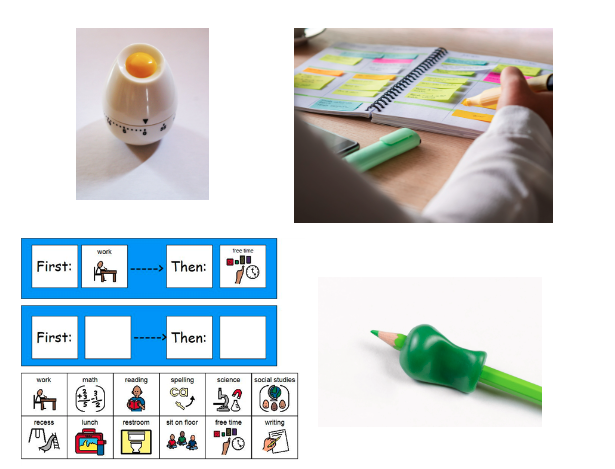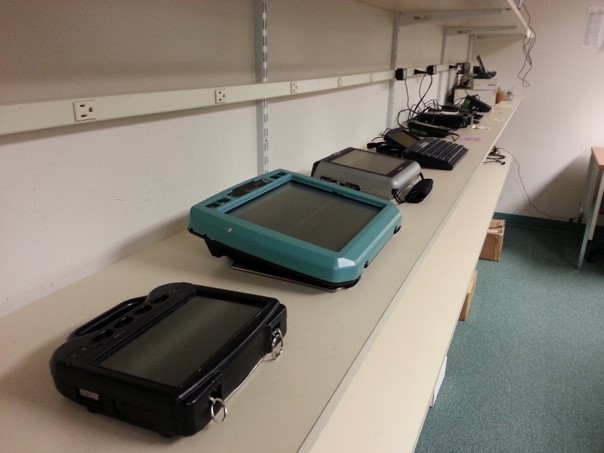The legal definition of assistive technology is long and a little complicated:
“Assistive technology device means any item, piece of equipment, or product system, whether acquired commercially off the shelf, modified, or customized, that is used to increase, maintain, or improve the functional capabilities of a child with a disability. The term does not include a medical device that is surgically implanted, or the replacement of such device.” Sec. 300.5 Assistive technology device – Individuals with Disabilities Education Act. (2022). Sites.Ed.Gov.https://sites.ed.gov/idea/regs/b/a/300.5
If you are looking for a brief definition of assistive technology, there are two important parts.
- Assistive technology is an item or piece of equipment. AT is not a person or a helper.
- Assistive technology helps people with disabilities to do something that is difficult or impossible because of their disability. It improves function.
As the AT definition states assistive technology is ANY system that is used to improve the ability to access the curriculum and goals of a student with a disability. Assistive Technology does not include only computer or tablet-based tools (often called high-tech tools) but also includes tools that don’t use electricity, are paper-based, or even a standard classroom tool that the student needs to make progress.
Low Tech AT
Low tech items are more simple and can include items that a teacher may use within the classroom for all students, but for the specific student with the IEP, these items are needed and without them, the student is not able to be successful. Examples can include using a picture schedule, a pencil grip, a slant board, special paper (i.e. different spacing, darker lines), a line guide for reading, and a contrast filter.

High Tech AT
High Tech AT usually runs on electricity and can include apps and computer programs, tools built into a computer program or operating system, or even entire devices.

What areas does assistive technology help with?
Assistive technology can be described by the area that it helps with. In the list below, you will see that many technology items-like tablets and computers are listed in several sections, that is because technology can be used in so many ways. Organizing AT in categories like the ones below may help you to think about the difficulties your student is having and the kinds of AT that might help to overcome barriers.
- Seating, Positioning, and Mobility – Some students are able to perform more tasks when they have the right height or type of chair. Moving around the school may require having special equipment such as a walker or wheelchair.
- Communication – Students who do not communicate the same way as their peers may benefit from alternative or augmentative communication. Examples include a communication book or communication device that speaks when a button is activated.,
- Computer Access – A student may need some additional equipment or a special type of computer, mouse, or keyboard.
- Motor Aspects of Writing – Students may be given different types of writing materials, use typing, or even record or use speech-to-text. The challenge with speech-to-text a student needs good speaking skills and there may be a lot of editing needed
- Composition of Written Material – Writing involves more than thoughts, you have to organize your ideas, and use correct grammar, vocabulary, and sentence structure.
- Reading – Reading includes both reading comprehension and actually knowing what a word says (called decoding). AT will focus on the specific needs of a student. If the student has good auditory comprehension skills then text-to-speech or audiobooks may be a good option for them. For a student who does not have listening skills at grade level, text-to-speech may not be a good choice.
- Mathematics – Math involves a lot of reading, writing, and organization skills. Depending on what difficulties a student has would depend on what tools will best support them.
- Organization – Some students may need help with staying organized and would do well with a system that supports them with reminders, color coding, or other prompts to help them with their specific area of need.
- Recreation & Leisure – Regardless of ability level, all students get to participate in physical education activities, as well as some fun activities which may vary by school. There are specialized tools that can help in these areas from soccer balls that make a sound for a student that has vision loss to sensory and adapted items.
- Activities of Daily Living – A student may need special support for changing clothes for the gym, using the restroom, and eating lunch or snacks with their peers. These can all are considered activities of daily living within the school.
- Vision – Depending on the student’s challenges many items are available from enlarging print, changing contrast, or using special tools to help support their vision…
- Hearing -Hearing supports could include an FM or sound field system which would help bring the sound of the teacher’s voice to them without as many background noises or have closed caption available for them when watching a video.
- Multiple Challenges – Sometimes one challenge a student has impacted what tools they will be able to use. This is where consideration may go deeper!

Teams are REQUIRED by federal and state law to consider whether a student needs assistive technology at every IEP meeting and provide data that was used to make the decision. Parents are a part of every IEP team. If you don’t agree or don’t understand what the team is saying in the IEP, you have a right to ask questions. If the team is not able to answer the questions with the data that they have at the meeting, more information will be collected. The school is required to give you information on outside resources that can help with assistive technology when the IEP is written. In Illinois, that means, information on how to contact the state assistive technology program IATP (Illinois Assistive Technology Project)
AT and the IEP
Assistive Technology must be documented in the IEP. There is no single location that will contain AT and it may be found in different locations depending on how your district structures the IEP. All IEPs contain the following sections, this is an outline of where you might find mention of assistive technology within the IEP. There are some places it must be mentioned and some other places where it be. Let’s take a look at a basic outline of an IEP document.
- PLAAFP – A statement of your child’s Present Level of Academic Achievement and Functional Performance (PLAAFP).
- This is the part of the IEP where your student’s current performance is reviewed. In this section, a team might note what assistive technology your student is using to achieve that present level, details about how the AT is working, and even the student’s thoughts on it. For instance, if a student says they don’t like AT that is important functional information and this is a good place to note that so everyone knows.
- This can also be a useful place to detail what has been done to train or implement assistive technology, representing your student’s present level of use and proficiency.
- Parent Input– for some students, the difference between what is seen in the classroom and what is seen at home is vastly different. With others, it is pretty much the same. This is why parent input is very important, be ready for the team to ask questions either to prepare for the meeting or at the meeting. If your student uses their assistive technology at home, have some examples ready. If they do not use it at home, make sure to provide that information as well.
- Annual Educational Goals
- Some districts and practitioners make the choice to add assistive technology to a goal. For example, “While using text-to-speech software Max will answer paragraph level comprehension questions with 80% accuracy by the end of the grading period”
- It is not required for assistive technology to be attached to a goal.
- Accommodations and Modifications
- Rewind all the way back, Assistive Technology at its heart is an accommodation. It doesn’t change the task, it makes it possible!
- The accommodations and modifications section is where assistive technology must be documented. In Illinois, even if assistive technology isn’t needed a team is required to say what they considered and why it is not needed.
- This section is also where many districts will document if staff, students, or family need to be trained on the assistive technology, as well as any notes on the equipment. If not documented here, that information should be in the conference notes or somewhere in the IEP.
- Transition Plan– Transition plans are started at 14 ½ years of age in Illinois. Once students graduate, assistive technology provides accommodations in the adult world. Information on following up on assistive technology can be an important part of this plan. There is expanded information on this on the Transition page.
While some local education agencies allow parents to purchase equipment their student has been using when they leave school, others do not. This is a local school district policy. Make sure to have this discussion with the team in advance.
AT Consideration
AT consideration is required by IDEA as well as the Illinois School Code and is part of every IEP process. During consideration the IEP team takes into consideration what tasks the student needs to do during their day, the school environment students need to access, as well as what the student’s strengths and needs are. The three core words in the law: Increase, Improve, and Maintain refer to the educational environment. A team needs to see the educational impact of the student’s disability and be able to match that with a tool, or item to help the student access their education.
A popular statement about AT is “It depends.” Without individually considering a student’s strengths and needs, as well as the environment they work in and the tasks they need to do, it is difficult to say if a tool will help. Because of this “it depends” on many different factors that the team needs to consider. Remember each student and situation is unique.
The increased use of 1:1 devices, the use of computers for instruction, and the inclusion of built-in accessibility features can sometimes encourage a team or student to discover and use AT accommodations. It is very important for these features to be identified as supports that the student must have to make progress in the curriculum and documented as such in the IEP.
Identification of AT supports is important for these reasons:
- If you were to move, the next school district needs to know what your student was using because it may not have the same built-in support.
- If it isn’t documented in the IEP no one knows that this is what was helping the student to be successful, and it could be lost in a transition even between grades. Also,
- Without documentation, AT can’t be used on many standardized tests.
- Older students and graduates need to have a record of what works for them so they can advocate for funding and get it after graduation.
There are many approaches to consider which can help a team set a direction. Worksheets like the following can help show data for the “why or why not” part of the consideration. Teams that know a student well will often have the knowledge and data needed to fill these in. When consideration is complex, it is nice to have these sheets as an organizing platform. All of the resources listed here are free:
SETT stands for Student, Environment, Tasks, and Tools. It is one of the more popular models to use when thinking about AT. On this website, there are free worksheets that can help guide the conversation. The worksheets help to compare tools, create a plan, and take data.
GPAT Created by the Georgia Project for Assistive Technology, this tool helps in identifying some of those things which may be provided to every student in the room, but are specifically helping your student! It is also easy for teams and parents to stay on the same page during a discussion, it is a 2-page worksheet, that has a supporting resource guide as well as a glossary.
Task-Demand Analysis – a website at the UIniversity of Illinois at Chicago, walks through the AT consideration process using a Task Demand Analysis.
WATI – the Wisconsin Initiative for Assistive Technology’s, ASNAT is ‘Assessing Student Needs for Assistive Technology” guide that offers in-depth information about the ways that AT can help students with various disabilities. You can search for a specific area of need and their checklists (download, ‘Using the AT Checklist – 4 pages) are extremely helpful when figuring out the type of AT to try.
If the IEP team does not feel they have the expertise to fully consider AT, there are statewide programs to help them.
When Assistive Technology may not be appropriate
There are situations where assistive technology is not needed, let’s highlight the three most common scenarios.
The first is that your child does not need assistive technology. This means that in the areas where they have difficulty with school or accessing the curriculum they are able to access their courses and the environment with other accommodations (typically those involving setting and time) and modifications. As long as the teacher changes the instruction, time periods, or setting to address your child’s needs, they will be able to benefit from instruction.
The second is that your child may still have difficulty accessing the curriculum or environment but there is no assistive technology for their specific difficulty. In this case, the team should identify or acknowledge that the area is difficult and let you know anything they did try. This is where a modification will likely be needed. For example, there is no AT which can help with processing speed or understanding. Our brains are still better than the tech! This doesn’t mean that something may not be invented, or that your student may gain a skill that allows them to access technology in the future. It is simply not the best option for access at the moment.
Third, it may be that there is a technology that may help your student though your student is currently not able to use it, or does not want to use it. There are programs that can help students do very complex tasks though they have many steps, and prerequisite skills, or they may not be oriented to the grade level or content your student needs. This example is more of a mismatch of the features of the tool.
